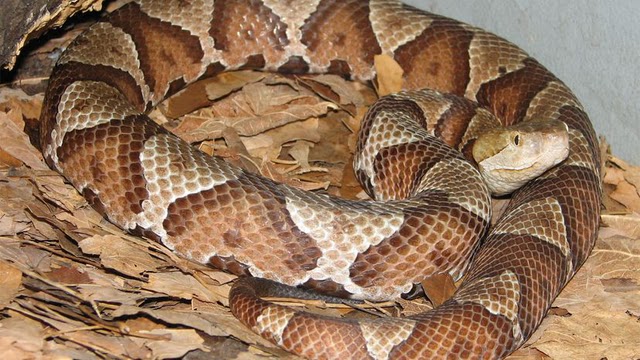Quck answer
Copperhead snakes are venomous, but their bites are rarely fatal to humans. However, it is still best to avoid contact with them as their venom can cause painful swelling and other unpleasant symptoms. These snakes are common in North America and can be identified by their copper-colored heads and hourglass-shaped markings on their bodies. If you encounter a copperhead snake, give it plenty of space and do not attempt to handle or provoke it. Instead, call a professional wildlife removal service to safely remove the snake from your property.
Wild Animals

The copperhead snake (Agkistron contortrix) is a venomous reptile with a distinctive pattern. While not typically aggressive, it will bite if threatened. Although rarely fatal, it is best to steer clear of these snakes. CDC/Wikimedia Commons
Judy Reed was simply trying to do laundry when a copperhead snake bit her. The Pennsylvania resident discovered the snake curled up on a shelf in her basement. While Reed survived, a man in Alabama was not as fortunate. Oliver Baker died from an allergic reaction to a copperhead bite. He had been walking his puppy when the incident occurred.
Copperheads are venomous, but their bites are not usually fatal to humans. These snakes, found throughout much of the eastern United States, have triangular heads and brownish bodies with hourglass-shaped markings. While copperheads, along with rattlesnakes and water moccasins, are among the three venomous snake species in the U.S., the Centers for Disease Control and Prevention reports that only about five people die each year from venomous snake bites. Seeking medical treatment is crucial, however, as permanent injuries and disabilities are much more common, affecting up to 44 percent of rattlesnake bite victims.
Where Do Copperheads Live?
Copperheads are prevalent in much of the eastern U.S., from Connecticut to Georgia and from western Texas to western Florida. These large snakes, measuring between 24 and 40 inches (61 to 102 centimeters) in length, are easily identifiable by their hourglass markings. They are often found in wooded areas with cover, as well as along streams and rivers, in abandoned farm buildings, and in desert canyons and sawdust piles.
Do Copperheads Attack Humans?
According to Jeff Beane, a herpetologist at the North Carolina Museum of Natural Sciences, copperheads do not typically attack humans. They only bite when they feel threatened or frightened, such as when someone steps on or near them. Copperheads defend themselves, but they do not go out of their way to attack people.
The copperhead snake (Agkistron contortrix) is named for its copper-colored head. Although there are other snake species called “copperheads,” Agkistron contortrix is the only true copperhead in North America.
The copperhead is a pit viper, similar to the rattlesnake and cottonmouth. It has heat-sensitive pit organs on each side of its head that help it detect prey at night. Its venom is a combination of proteins and enzymes that breaks down red blood cells. The copperhead feeds mostly on small mammals, but will also eat large insects. When attacking a larger mammal, it will bite and wait for the venom to weaken it before tracking and attacking it again.
Unlike other snakes, copperheads are social and hibernate in groups during the winter. During spring mating, males become aggressive and fight to overpower rivals in front of females. Those who lose are emasculated and will not challenge another male. Males use their tongues to detect pheromones emitted by females and court them until they are ready to mate. Females can reproduce asexually through parthenogenesis or store sperm to fertilize their eggs.
In the summer, copperheads are active at night, but during fall they are active during the day. They hibernate from November to April, but may come out to soak up the sun on warm days.
FAQ
1. What is a copperhead snake?
A copperhead snake is a venomous pit viper that is commonly found in North America. It gets its name from the coppery color of its head. These snakes are medium-sized, with adults typically ranging from 2 to 3 feet in length.
2. Are copperhead snakes dangerous?
Copperhead snakes are venomous and can cause painful bites, but they are not usually lethal to humans. However, it is best to avoid contact with them and seek medical attention if bitten.
3. Where are copperhead snakes typically found?
Copperhead snakes are found throughout much of the eastern and central United States, from Florida to Illinois. They prefer wooded areas and are often found near streams or rocky outcroppings.
4. How can I identify a copperhead snake?
Copperhead snakes have distinctive copper-colored heads and hourglass-shaped markings on their bodies. They also have vertical pupils and heat-sensing pits located between their eyes and nostrils.
5. What should I do if I see a copperhead snake?
If you see a copperhead snake, it is best to leave it alone and give it plenty of space. Do not attempt to handle or capture it.
6. What do copperhead snakes eat?
Copperhead snakes are carnivorous and primarily eat small rodents, lizards, and insects.
7. How do copperhead snakes defend themselves?
Copperhead snakes will often use their camouflage to avoid detection, but if threatened, they will hiss, vibrate their tails, and strike if necessary.
8. Can copperhead snakes swim?
Yes, copperhead snakes are capable swimmers and can often be found near bodies of water.
9. What is the lifespan of a copperhead snake?
Copperhead snakes typically live for around 10 years in the wild.
10. How can I prevent copperhead snake encounters?
To prevent copperhead snake encounters, it is best to avoid areas where they are commonly found, such as wooded areas near streams or rocky outcroppings. Wear protective clothing and use caution when hiking or working outdoors.





Leave a Reply